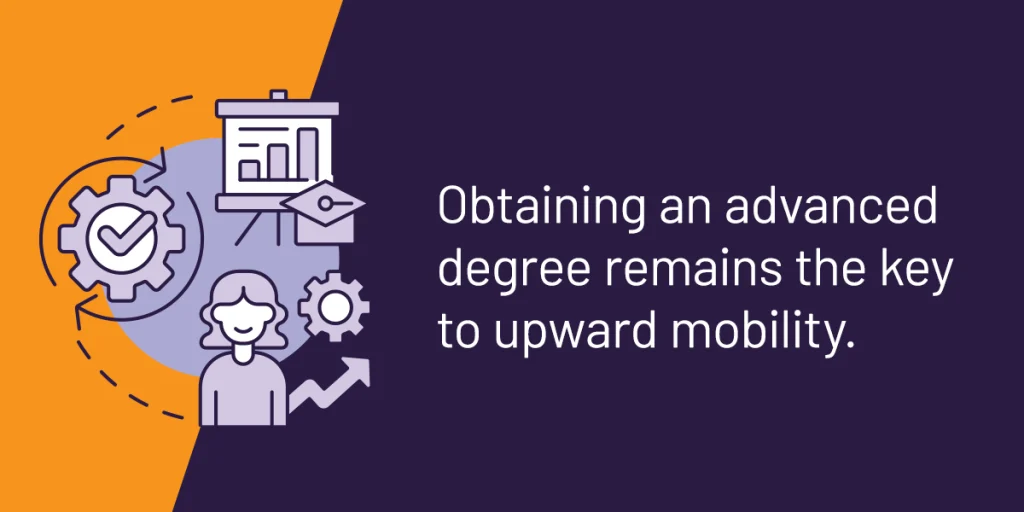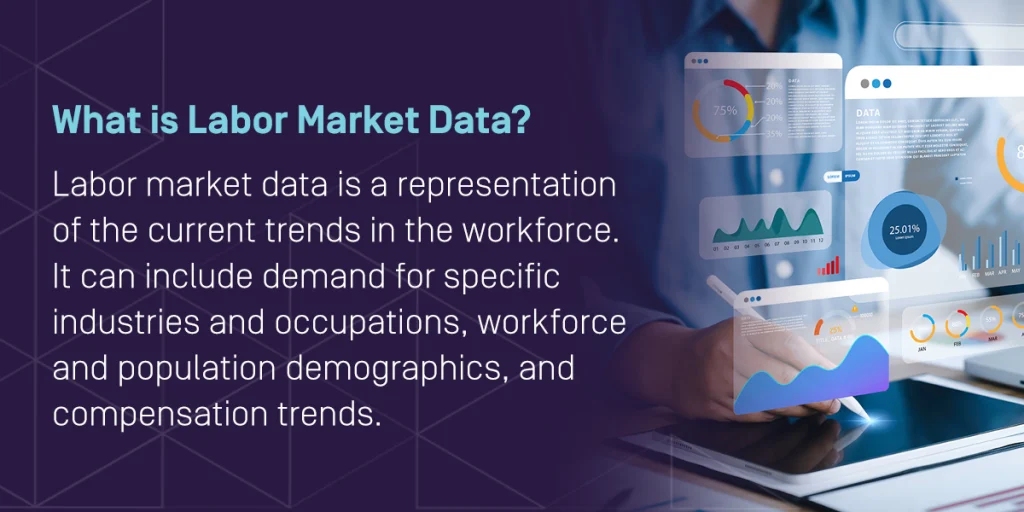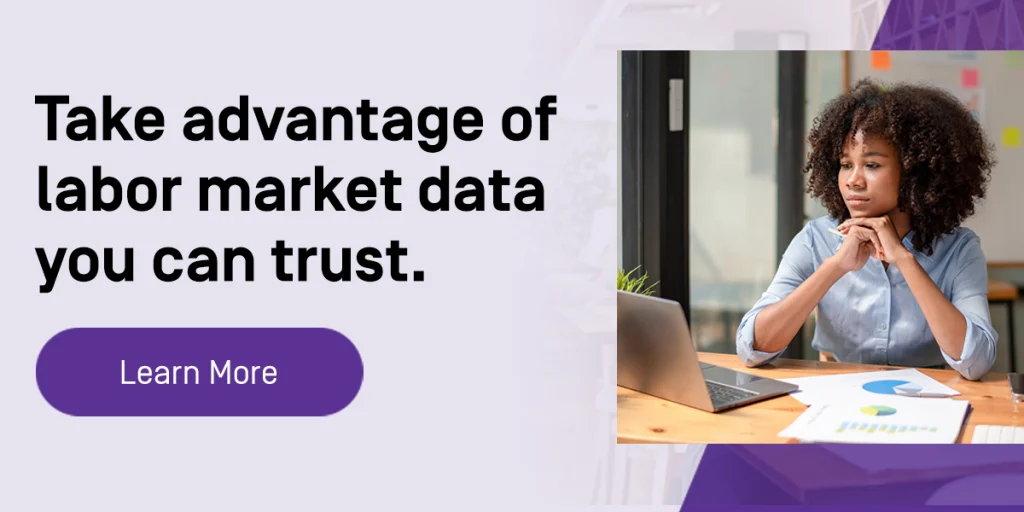



Declining enrollment is top of mind for many professionals in higher education. From 2019 to 2021, undergraduate enrollment declined by nearly 8%, and community college enrollment dropped 15%, according to research from the National Student Clearing House. Though recent figures show some slight improvements to this trend, many higher education institutions are still struggling to attract new students.
Multiple factors contribute to declining enrollment, including rising tuition costs, concerns about student debt, and a belief among some students that higher education isn’t as valuable as it once was. To set themselves apart from the competition, colleges and universities can use labor market data to identify emerging trends and develop programs that prepare students for today’s labor force. Read on to learn more about how you can use labor market data to strengthen program offerings at your institution to combat declining enrollment.
Though the cost of higher education and concerns about student debt are part of the story, there are other factors that contribute to the current wave of declining enrollment. Students who had their educational journey disrupted by COVID-19 — whether they were in high school or enrolled in a college or university at the time — are facing unprecedented levels of disillusionment.

When in-person learning shut down in 2020, many students struggled to adjust to the lack of academic structure and support. The combination of isolation, fear of how the pandemic would affect their future, and the switch to online learning caused many students to question the point of enrolling in a higher education institution in the first place. The learning that once felt exciting, inspiring, and tactile suddenly felt dull, aimless, and distant. Finding a way to spark motivation and curiosity among this group of students has been an uphill battle, and educators are being challenged to combat this “militant apathy.” What are the implications on our society if a generation of young adults fails to see the value of education?
With an abundance of open positions in food service, hospitality, and retail, some young adults have chosen to join the workforce rather than continue their education. Unlike previous generations, this group of adults doesn’t buy into the idea that higher education is the best path for them to obtain financial success. Though this may be the best decision for some, obtaining an advanced degree remains the key to upward mobility.
These are the challenges that higher education leaders are grappling with, yet there are a number of creative solutions that institutions are using to bolster student engagement and reignite a love of learning.

Higher education institutions are using a variety of creative tools to increase student engagement. Two innovative approaches that are in the early stages of development are the gamification of learning and offering microcredentials.
Gamification can be used in higher education by incorporating game-like elements into learning. For example, institutions could use a point system to incentivize students to complete assignments and quizzes. Another approach is to create leaderboards to encourage friendly competition among students.
Microcredentials are a way for students to advance specific skills or knowledge areas, without the cost and rigor of earning a bachelor’s degree. These credentials can be beneficial for career advancement and can help increase student engagement by providing a tangible goal to work towards on a shorter, more flexible timeline.

Though these methods are certainly creative, they have significant limitations. If students are struggling with academic apathy and do not understand the value of their education at a base level, these methods may do little to ignite that passion. Furthermore, integrating gamification software on campus or developing microcredentials from scratch can be both time-consuming and costly. When a majority of state legislatures are spending less on funding public higher education now than in the previous economic downturn in 2008, most institutions have little resources to spare.
Colleges and universities don’t need to make expensive decisions on experimental approaches to combat declining enrollment. Instead, they can review their existing programs and find ways to communicate the value of those degrees. Institutions can leverage what they’re already doing well, and focus their improvements where it will have the most impact.
Utilizing labor market data can help colleges reinforce what they already know, verify labor trends, and make existing programs stronger. By offering programs that align with current trends and skills, colleges and universities can better prepare students for the workforce and increase their employability upon graduation.
Labor market data is a representation of the current trends in the workforce. This data can include regional, candidate, and employer demand for specific industries and occupations; workforce and population demographics; and compensation trends. Traditionally labor market data is difficult to obtain, ever-changing, and a challenge to extract meaning from, yet many institutions rely on this data to make important decisions. This can make the data collection process feel like a daunting pressure cooker — one wrong move could have lasting consequences on an institution’s success. However, by using a software system to help gather labor market data, you will have the security of accessing accurate, timely information that is put into context.

Quality labor market data helps institutions make informed decisions about their programming. This helps them verify that they are offering classes and majors that directly translate into real-world skills. When students know that their education will have a direct application to their career, they can more easily see the value of earning a degree. Institutions can use also labor market data to partner with employers to offer internships, apprenticeships, and other work-based learning opportunities to enhance students’ resumes and increase their chances of securing employment after graduation.
Labor market data can verify the salary range a college graduate can expect to earn in that field, encouraging more students to pursue higher education to remain upwardly mobile, instead of going directly into the workforce after high school. When institutions can clearly communicate the value of their degrees through timely labor market data, they also set themselves apart from the competition and look much more appealing to prospective students. Having the right resource to access labor market data increases student success, improves retention rates, and helps institutions thrive.
Watermark is pleased to announce our new partnership with Lightcast. Well-regarded for delivering cutting-edge labor market data through their collection of software products, APIs, and consulting products, Lightcast is an expert in labor market analytics for educational institutions. This partnership furthers our commitment to provide an insightful suite of products that enable our customers to operate more effectively and efficiently.
This partnership was born out of our mutual desire to help higher education institutions strengthen their ability to achieve their missions, more effectively recruit students, and meet the needs of the communities they serve. The Watermark team was eager to expand access to essential labor market data for our clients by embedding key data from Lightcast within our existing program review and insight workflows.
For our Watermark Planning & Self-Study product, we have an exciting new offering: the Market Landscape Data Pack. This is the cornerstone of our Lightcast partnership, and it provides many benefits that can be utilized throughout your institution.
With our Market Landscape Data Pack, your institution can utilize consistent, reliable data that seamlessly integrates into your existing workflows in Planning & Self Study. Enjoy additional insights without any hassle. Read the press release to learn more about the benefits of this partnership.































































































































































































































































































































































































Submit this form to schedule a meeting with one of our reps to learn more about our solutions. If you need customer support instead, click here.